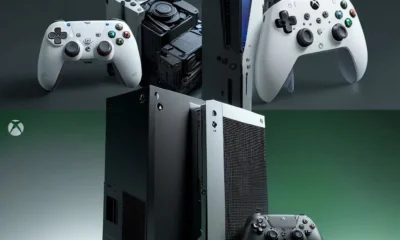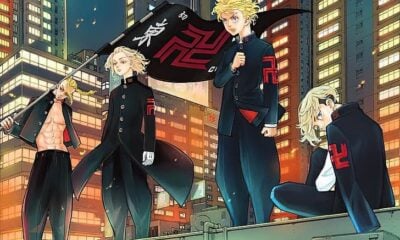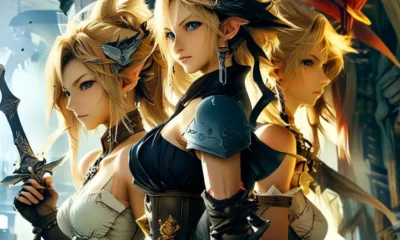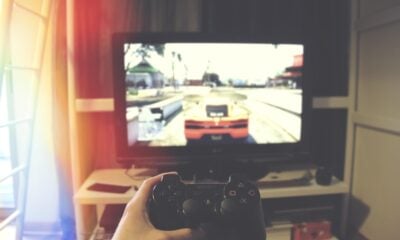Level By Level
‘Super Mario Odyssey’ Level by Level: Cascade Kingdom
Already among the most positively received games of all time, Super Mario Odyssey expands upon the open, flexible design philosophy of Super Mario 64 while incorporating contemporary design sensibilities and twenty years worth of polish. And like its watershed grandfather, Odyssey is sure to carve its own special niche of influence and esteem in the gaming pantheon. But is it truly the near-perfect experience many believe it to be, or might a deeper inspection reveal some telling blemishes? As I already have Super Mario 64, I will examine each of Super Mario Odyssey’s kingdoms in an attempt to glean insight into their stumbles and successes. In this entry, I will be taking a look at the game’s second course — Cascade Kingdom.
After toppling Topper in the Cap Kingdom, Mario captures a spark pylon to quickly transport to the nearby Cascade Kingdom in search of one of Bonneton’s undamaged aircrafts. Upon arrival, he is tasked with earning his first power moon, after which he discovers a rusted ship called the Odyssey. After traversing Fossil Falls and beating its boss, he is able to use the power moons he collects to power the Odyssey to the Sand Kingdom.
Purely in terms of topography, Fossil Falls’ layout seems to mimic Bonneton’s to a tee. From start to finish, Mario starts in the southernmost and lowest point and gradually moves upward and northwest until reaching the boss. But in its ambiance, liveliness, and color palette, Fossil Falls could hardly be more different. Here, cascading waterfalls surround the playable plateau, replacing the phantasmic buildings of the previous level. And while Bonneton was defined by monochrome, Cascade Kingdom is a lush prehistoric world where even the rocks have a reddish hue and the Burrbo enemies come in every color of the rainbow. Upon the first visit, Fossil Falls is a sight to behold.
Cascade Kingdom’s centerpiece is its namesake waterfall. Not only is it placed in the center of the map, but the main pathway winds up and around the waterfall while many locations and moons are titled in relation to it. Its majestic presence puts the T-Rex capture’s inimitable brute force within a larger context of an untamed natural world. Along with the vibrant art style, the waterfall enlivens the surroundings, a surprising feat given the Cascade Kingdom is one of the few kingdoms without non-enemy residents.
While moving from the starting spawn point to the boss battle, the player earns their first moon by capturing a Chain Chomp and flinging it at a pillar that collapses to create a bridge crossing the waterfall basin. This first moon accentuates the centrality of captures to Odyssey’s ethos, but the unintentional creation of a bridge underscores the game’s notably stagnant levels. Throughout the game, there is very little meaningful decision-making that alters the course, a noteworthy omission given how empowering it is to solve Super Mario 64’s puzzles by determining the water level in Wet-Dry World or clock hand placement in Tick Tock Clock.
Instead, Odyssey prefers scripted events told through narrative and cutscenes rather than player-driven modular changes. This is underscored by the gradual unlocking of Cascade Kingdom’s moons throughout the game. At first, the player can only nab the power moon described above. After that, another couple open and the player can confront the boss. After that, another ten or so open. Then, others open depending on which missions have been completed in other kingdoms and whether or not the player has beaten Bowser. While this content gating gives players a reason to return, it also disguises Cascade Kingdom’s lack of depth and the player’s lack of meaningful interaction with the course. Though Nintendo and its fans repeatedly express how much Odyssey’s design owes to Super Mario 64’s, fundamental design decisions like dropping moons at seemingly random times and places and altering courses through cutscenes alone funnel play in a manner antithetical to Super Mario 64’s openness.
Cascade Kingdom’s captures, though largely enjoyable, reveal the repetition of many of the game’s captures. While Odessey claims to have 52 unique captures, subtracting the abundant reskins show only 34 captures have unique move sets. In the Cascade Kingdom, the player gains access to the Chain Chomp, Big Chain Chomp, and Broode’s Chain Chomp, all of which are effectively identical. Fortunately, these particular captures are premised around a versatile and responsive mechanic where the player pulls them in one direction to slingshot them in the opposite direction. This can be used to destroy destructible architecture, attack enemies, or ricochet one Chain Chomp off of another. It’s a clever interpretation of a classic Mario character that feels unlike any other capture (even though it is similar to the Volbonan and Pokio in principle). And in the secret room where the player effectively plays Chain Chomp billiards, it’s one of the few captures that feels as thoroughly explored as a power-up in Galaxy 2.
Cascade Kingdom’s other main capture is the T-Rex, an initially thrilling but ultimately shallow transformation primarily used to destroy the blocks out of Chain Chomps’ reach. Basically, a taller, unleashed Chain Chomp, it seems strange to place it on the same level as six Chain Chomps, as they interact with the stage in essentially the same manner. The small size of the course along with a total lack of opportunity to run at full speed or meaningfully use the attack button (which itself seems to have no purpose since the T-Rex already damages everything it touches) further underscores its odd placement. Although the T-Rex also receives its own secret area, that area’s design does not play well to the T-Rex’s unique abilities, instead feeling awkward and anticlimactic.
Fortunately, Cascade Kingdom’s moons are a small step above Cap Kingdom’s. Of the stage’s 40 moons, only five to ten are stumble-upons the player can easily grab while traversing the level on the beaten path. There are also several other moons the player perform a small task to reach (like jumping across a couple of platforms or breaking a wall with a Chain Chomp). These moons can also feel undeserved, but at least they serve as a reward for something more tangible more than happening across a glowing patch of earth. Another ten moons lie in five secret rooms, most of which incorporate Cascade Kingdom’s art or themes. Along with the Chain Chomp room, the gusty wind room is a highlight. It introducing some clever ideas, like using Cappy to ride gusts of wind to reach an otherwise inaccessible area, unfortunately never expanded upon elsewhere. Most of the remaining twenty-ish moons are repeats, such as finding Peach, catching a rabbit, and purchasing a moon for 100 coins.
Like the Cap Kingdom, Cascade Kingdom lacks moons unique to the level. Its stumble-upons provides a bit more challenge and diversity, but its captures and themes are woefully under-integrated. Though some moons are cleverly hidden, almost all feel more like scavenger hunts than tests of platforming or puzzle-solving prowess. This is especially true of the post-game moons, which are scattered around the map in what feels like an attempt to artificially extend the game’s lifespan. These haphazard and repeat moons are a running problem with Odyssey, but Cascade Kingdom’s small stature means players pick up new stumble-upon moons mere seconds away from others. Given the overabundance of moons in general, replacing stumble-upon moons with bundles of coins could have made them feel less trivial (because coins provide the tangible function of allowing the player to purchase items) while giving appropriate weight to the moons focused on platforming, puzzles, and combat.
As the first fully-featured course of Super Mario Odyssey, Cascade Kingdom presents the player with some of the game’s greatest strengths and weaknesses for the first time. On one hand, the game is a sensory splendor. Whether looking at the waterfalls in the background, watching the grand hand-sweeping gesture Mario uses when powering the Odyssey with moons, or listening to the vibrant Galaxy-like music, the game can be an audio-visual delight. And in some secret rooms and 2D areas, Odyssey’s design occasionally flirts with genius.
But at the same time, Odyssey strives so hard to prove its openness and depth that it often undermines itself. Whether boasting about its artificially high number of captures, scattering moons nonsensically, or cramming too much into a space to make optimal use of it, Odyssey betrays its ancestors through its overindulgence. These flaws show up in nearly every kingdom, but Cascade Kingdom’s small size emphasizes the extent to which it can impact the player’s relationship with the level. And it was playing the Cascade Kingdom for the first time that made me wonder if Super Mario Odyssey was actually the spiritual successor to Super Mario 64 it was advertised to be or an open-world evolution of Super Mario 3D World struggling to unfold itself onto a broader canvas.

-

 Features4 weeks ago
Features4 weeks agoThis Upcoming Romance Anime Might Just Break the Internet; Trailer Just Dropped!
-

 Features3 weeks ago
Features3 weeks agoDon’t Watch These 5 Fantasy Anime… Unless You Want to Be Obsessed
-

 Features2 weeks ago
Features2 weeks ago“Even if it’s used a little, it’s fine”: Demon Slayer Star Shrugs Off AI Threat
-

 Culture2 weeks ago
Culture2 weeks agoMultiplayer Online Gaming Communities Connect Players Across International Borders
-

 Game Reviews3 weeks ago
Game Reviews3 weeks agoHow Overcooked! 2 Made Ruining Friendships Fun
-

 Features5 days ago
Features5 days agoBest Cross-Platform Games for PC, PS5, Xbox, and Switch
-

 Guides4 weeks ago
Guides4 weeks agoMaking Gold in WoW: Smart, Steady, and Enjoyable
-

 Game Reviews3 weeks ago
Game Reviews3 weeks agoHow Persona 5 Royal Critiques the Cult of Success
-

 Features2 weeks ago
Features2 weeks ago8 Video Games That Gradually Get Harder
-

 Features1 week ago
Features1 week agoDon’t Miss This: Tokyo Revengers’ ‘Three Titans’ Arc Is What Fans Have Waited For!
-

 Game Reviews5 days ago
Game Reviews5 days agoFinal Fantasy VII Rebirth Review: A Worthy Successor?
-

 Guides1 week ago
Guides1 week agoHow to buy games on Steam without a credit card




















